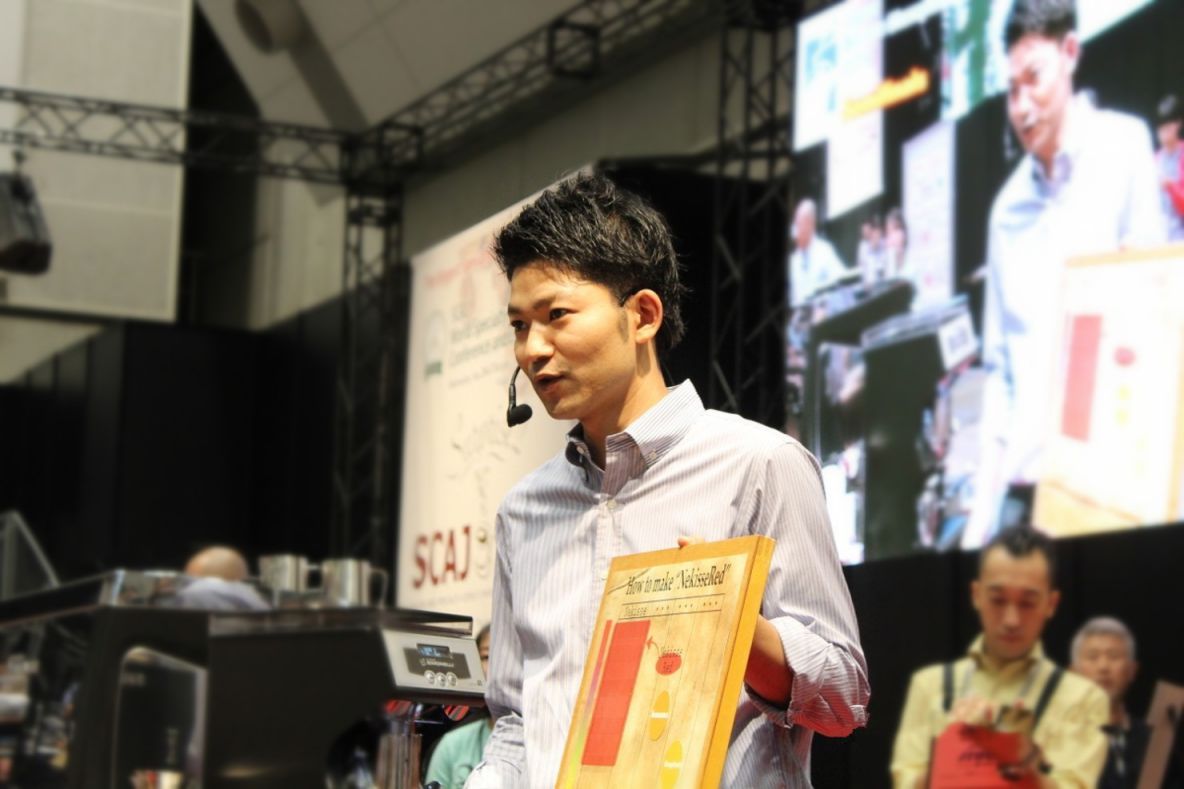Listen to Starbucks baristas tell the story of coffee
Follow the caf é (Wechat official account vdailycom) and found that Beautiful Cafe opened a small shop of its own.
When you bring a cup of warm coffee to your mouth, a coffee experience for you officially begins. A cup of coffee that has been refined and condensed into essence will bring you more than just the enjoyment of taste. What's more, it is a process of multi-sensory cooperative evaluation.
Starbucks star baristas will advise you to follow the following four steps for coffee tasting; first of all, the main news. Cover the small cup with both hands to gather the aroma of coffee, then inhale deeply and smell it. The taste of a kind of coffee is first expressed by smell. In fact, people's sense of taste mainly comes from the sense of smell-which is why aromatic coffee is satisfying. After smelling the fragrance, suck the coffee quickly and make a sucking sound, let the coffee fully infiltrate your tongue, let the aroma reverberate in your mouth, and finally the aroma will reach our main taste sensing organ-the nose. Let the nasal cavity fully feel the unique taste of this coffee. After that, determine which parts of the tongue experience these flavors when tasting coffee. As the final step in coffee tasting, expression is a process that gives you the freedom to describe how a coffee makes you feel in a variety of ways. So that you can find the cup of coffee that suits you more quickly.
About the aroma of coffee
The aroma comes from our sense of smell and is used to describe the smell of coffee, which is usually described by earthy aromas, spices, flowers and nuts.

About the acidity of coffee
In terms related to coffee tasting, acidity is a common description in addition to smell. The word acidity does not refer to the degree of sour or bitter taste, acidity means the degree of liveliness, intensity and freshness of taste. To understand what acidity is all about, you can imagine the difference between pure water and bubble water.
There is a kind of Latin American coffee called Super Colombian Narino, which has a very lively taste, so we say it has a high acidity. On the contrary, the taste of Sulawesi is very mellow, so let's say that this kind of coffee has low acidity. Starbucks lounge mixed coffee TM, mellow, approachable, with delicate soft cocoa and lightly roasted nuts, light and elegant taste, medium acidity.
About the mellowness of coffee
The weight or density of a drink felt by the tongue. The mellowness of the drink varies from low to high. To make you understand this concept, we sometimes use the word "syrup" to describe a high-alcohol coffee, such as Sumatran coffee. Starbucks Fengwu Xiangyun comprehensive coffee TM, with a balanced flavor with herbal and cocoa aromas, medium mellow.
About the flavor of coffee
This is an overall impression left by the combination of smell, acidity and mellowness. What do you think of when it comes to the taste of coffee?
For example, we often say, "when you drink Kenyan coffee, you think of grapefruit," which means that we have some associations between these two things. However, when we say this, we do not mean that "Kenyan coffee has the taste of grapefruit", its taste is the unique taste of coffee. Starbucks low Xianglong comprehensive coffee ®, it has a strong herbal, spicy and earthy aroma. There are many ways to describe the taste of coffee, everyone's taste is different, and the description will be different.
About Starbucks
Star baristas are the soul and core of Starbucks' experience. Their coffee enthusiasm, skilled skills and deep emotional connection with their customers have laid the foundation for Starbucks' success. At Starbucks, you have to go through at least two weeks and more than 80 hours of rigorous training in the store to become a star barista. The training includes comprehensive theoretical knowledge of coffee, skills of handmade Starbucks coffee drinks, coffee tasting ability, communication and service ability to enhance customer experience, and in-depth understanding of Starbucks' core values and mission-to stimulate and nurture humanistic spirit. After the training, you must pass the certification examination of qualified trainers before you can finally get the Starbucks "star barista" qualification, and begin to work towards the dream of becoming a black apron "coffee master". And make high-quality drinks for customers and provide a pure Starbucks experience.
[related reading]
The cultivation process of Coffee
People often mistakenly think that coffee is grown directly with raw beans, but it takes a long time to grow coffee only to find that it doesn't sprout. In fact, coffee is grown with seeds with endocarp (Parchment). "Inner fruit" (or "sheepskin" or "paper skin") refers to the tea-brown hard skin that wraps the coffee seeds, and the coffee beans attached to that layer are called "Parchment Bean".
Plucking the skin of the fully ripe bright red coffee fruit (called red cherry), you can see that there is yellow flesh under the red skin, which is a bit like a cherry, the flesh is sweet, there is a pair of symmetrical seeds in the center, and there is a slippery film around the seeds. Wash the film off with water to become "shelled beans". Peel off the endocarp and you will see the seeds covered with Silver Skin. The seed is the raw bean actually used as the raw material of coffee.
1. Sowing seeds
The coffee wrapped with endocarp will be planted in the seedbed (a plastic flowerpot called "pot") and will germinate in 40 to 60 days and grow to about 50 centimeters in about 6 months after germination. At this stage, the seedlings are still fragile and must be covered with cold gauze and other things to block direct sunlight.
The seedlings blossomed about three years after they were transplanted from the seedbed to the garden. During this period, countries such as Central America that use hand-picking to harvest coffee beans will prune the branches of coffee trees and remove the lower side branches in order to improve the efficiency of harvesting coffee. The flowers of the coffee tree are white five-petal flowers with a jasmine scent. The flowers wither in a few days, then grow small fruits, and turn red in 6 to 8 months to represent maturity.
The peak of the coffee harvest is in the 6-10 years after the coffee tree grows, and then the harvest will gradually decline. In addition, if the coffee tree grows too high, it will also lead to a poor harvest, so coffee farmers will cut off the trunk from 30cm to 50cm above the ground, allowing it to regenerate branches and renew productivity. This step is called "Cutback". If combined with climate, fertilization, resistance to diseases and insect pests and other favorable conditions, coffee trees can last 20 years, or even 50 years of continuous fruit.
Wild coffee trees can be as high as 10 meters, but generally planted coffee trees are maintained at a height of about 2 meters in order to harvest conveniently. Arabica coffee varieties are being improved year after year, hoping to reach the level of high harvest, high virus resistance, early harvest, strong environmental adaptability, and, of course, the appropriate height of trees to make harvesting more efficient.
two。 Harvest
The harvest time and method of coffee vary from place to place, generally speaking, about once or twice a year (sometimes up to three or four times). The harvest time is mostly in the dry season. In Brazil, for example, around June, it starts in the north-eastern state of Bahia and ends in October in the southern state of Parana. The harvest period of Central American countries is from September to January of the following year, from lowlands to highlands.
Harvesting methods can be divided into two categories, one is hand picking method, the other is shaking method.
(1) hand picking
With the exception of Brazil and Ethiopia, most Arabica coffee-producing countries are harvested by hand. Hand picking involves not only picking ripe bright red coffee fruits, but also sometimes along with immature cyan coffee fruits and branches, so these immature beans are often mixed with refined coffee beans, especially when refined by natural methods. If these beans are mixed with baking, they will produce a disgusting stench.
(2) shake-down method
This method is to hit the ripe fruit or shake the coffee branch with a random stick, so that the fruit falls and accumulates into a pile. Larger estates will use large harvesters, while small and medium-sized farms will harvest with a sea of people mobilized by the whole family. This method of shaking the fruit off the ground is easier to mix with impurities and defective beans than the hand-picking method, and beans from some places can be stained with a strange smell or fermented because the ground is wet. Producers of Robusta coffee beans such as Brazil and Ethiopia are mostly harvested in this way.
Countries harvested by shaking and falling method also use natural drying method to refine coffee beans. Coffee blossoms in spring, bears fruit in summer and harvests in winter, so it is very difficult to harvest and dry in places where there is no clear distinction between drought and rainy seasons. in the rainy season, it is impossible to use natural drying. Therefore, coffee is suitable for growing in areas with distinct dry and rainy seasons.
Important Notice :
前街咖啡 FrontStreet Coffee has moved to new addredd:
FrontStreet Coffee Address: 315,Donghua East Road,GuangZhou
Tel:020 38364473
- Prev

Share the entrepreneurial story of the Japanese barista champion
Follow Kaipai (Wechat official account vdailycom) found that the beautiful cafe opened a small shop of its own for Rec Coffee Cafe in Fukuoka, Japan, which officially opened in March this year, and its two owners took part in the 2014 Japanese barista competition, among which Ishizawa won the Japanese barista competition. The achievements of these two young baristas benefit from the development in Japan today.
- Next

From model to champion of WLAC Coffee pull Art Competition in China
Following Cafe Review (Wechat official account vdailycom) found that Beautiful Cafe opened a small shop of its own Li Qi, Mellon Champion barista, Mellon training Department Intermediate trainer, engaged in the coffee industry for 3 years. Competition experience: she won the SCAE certified barista 2016 WLAC World pull Art Competition China final champion 2016 WLAC World pull Art Competition runner-up.
Related
- What is the meaning of lactic acid fermentation with coffee bean treatment?
- How to judge the state of foam by sound?
- How does the latte pull out the unicorn pattern? Come to get for a little trick to improve the flower pull!
- Will flower pulling affect the taste of the latte?
- Do you know the history of coffee?
- The difference between honey treatment and sun washing what is raisin honey treatment?
- What kind of milk can a novice use to make coffee foam to keep the foam longer? The correct method and skills of milking tutorial sharing
- Why do washed coffee beans taste sour? Flavor characteristics of washed Coffee
- Introduction to the skill of how to practice the size and height of water injection around the circle of hand-brewed coffee
- How do beginners practice coffee flower drawing from scratch?

